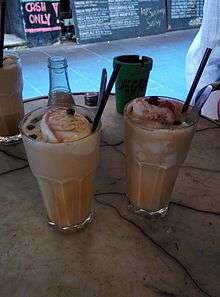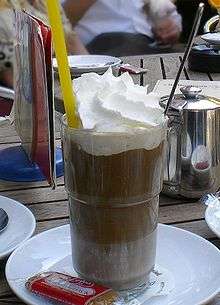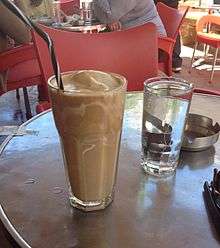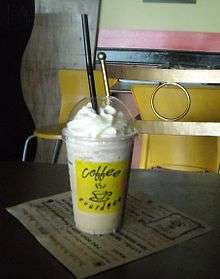Iced coffee
.jpg)
Iced coffee is cold coffee. The iced latte and iced mocha are examples.
There are various brewing methods, with the fundamental division being cold brew – brewing the coffee cold, yielding different flavor, but not requiring cooling – or brewing hot and then cooling, generally by simply pouring over ice or into ice cold milk. In case of hot brewing this can be normally brewed coffee (drip, press pot, etc.), or espresso. In case of hot brewing, sweeteners and flavorings are often mixed into the hot coffee before cooling, due to higher solubility in hot water. Alternatively, syrup (sugar pre-dissolved in water) may be used, particularly gum syrup. Pre-packaged iced coffee is available as a grocery item in several countries. Regardless of brewing method, iced coffee is generally brewed at a higher strength than normal coffee, due to the dilution caused by the ice.
History
Mazagran, a cold, sweetened coffee beverage that originated in Algeria[1] circa 1840, has been described as "the original iced coffee".[2] It was prepared with coffee syrup and cold water.[2]
Frozen coffee beverages, similar to slush, are documented in the 19th century, often called "café frappé (à la glace)".[3][4] Similar is the Italian granita al caffè.[5]
Coffee brewed then chilled with ice, called "iced coffee", appears in menus and recipes in the late 19th century.[6]
Iced coffee was popularized by a marketing campaign of the Joint Coffee Trade Publicity Committee of the United States in 1920.[7] Much later, it was marketed by Dunkin' Donuts and Starbucks.[8]
Serving
Iced coffee may be served already chilled, or poured hot over ice. Because sugar does not dissolve readily into cold liquids, it must be added either directly to the hot base, or to the finished product in the form of syrup.
Variations by country
Australia

In Australia, iced coffee is occasionally served with ice cream and whipped cream. The drink may also include syrup, cream, cocoa powder or coffee beans. The result is something like an unblended milkshake. Some commercial varieties of iced coffee are made from instant coffee or espresso coffee, while others contain only coffee flavouring. Iced coffee has been sold commercially in Australia since the late 19th century in the form of a syrup, an example of which is Bushells Coffee And Chicory Essence.
Iced coffee is commonly available as a prepackaged, ready to consume drink. Ice Break and Dare are arguably the most popular Iced Coffee brands in Australia today at grocery stores. In South Australia, Farmers Union Iced Coffee has outsold Coca-Cola and is one of the state’s biggest brands.[9] The brand is available in other states. Pauls "Territory's Own" Iced Coffee is hugely popular in the Northern Territory and Norco Real Iced Coffee is big in Northern New South Wales and South East Queensland. Other iced coffee varieties include Breaka, Big M, Brownes Chill, Moove, Masters, Dare, Max, Fleurieu iced coffee, Rush and Oak.
Canada
In Canada, the popular Tim Hortons coffee chain sells iced cappuccinos, known locally as Ice Capps. The chain has also recently introduced traditional iced coffee to its Canadian menu in addition to its U.S. menu. Other fast-food and beverage chains also provide iced coffee. A June 2016 study by research firm NPD found that the popularity of iced coffee drinks had increased by about 16 percent over the same period a year earlier.[10]
Chile
In Chile, iced coffee is called café helado (iced coffee).It is very popular in the summertime. Café helado is composed of espresso or coffee powder, chantilly cream, sugar, cinnamon, vanilla, chocolate or vanilla ice cream, manjar (dulce de leche) and ground almonds or nuts.
Czech Republic
In Czech Republic iced coffee is called "Ledova Kava".
Germany

In Germany there are different types of Eiskaffee (coffee with ice cream). The most widespread form is a flavoured milk drink similar to Australian iced coffee, generally spelled as Eiscafé (from the French café) and available in German coffeehouses and in Eisdielen (ice cream parlours). It consists of filtered, hot brewed and cooled coffee with vanilla ice cream and whipped cream on top. However, this type of iced coffee is rarely available in German supermarkets. The most widespread form of iced coffee in supermarkets is a canned version from a variety of brands with different flavours such as Cappuccino and Espresso. This iced coffee is very similar to the canned iced coffee in the UK and in the case of some brands (particularly Nestlé) actually the same product.
Greece

In Greece, one of the most popular coffees is a variation of iced coffee called Frappé, invented by Dimitrios Vakondios in 1957. The preparation entails mixing coffee, water, and optionally, sugar, together using either an electric mixer or a shaker to create a foam. Subsequently, milk is optionally added followed by ice cubes, and the remainder is topped with water. It became well known outside of Greece as a result of the 2004 Summer Olympics in Athens, during which many tourists became fond of it and an article in the Los Angeles Times was published about it. Since its founding, Frappe became a very popular drink in Cyprus, and in Romania.
Other popular iced coffee beverages in Greece include Freddo Cappuccino, which is topped with a cold milk-based foam known as aphrogala (Greek: αφρόγαλα), and Freddo Espresso, which despite their Italian names, differ greatly in taste and preparation from their Italian counterparts; as well as cold Greek coffee.
India
Iced coffee in India usually consists of instant coffee mixed with cold/frozen milk in a blender, producing a thin, coffee-flavored smoothie or often mixed with vanilla ice cream for thicker consistency. South Australians, especially in Adelaide, are also known for this drink. A more upscale version is popular in the espresso bar chains Barrista and Cafe Coffee Day. This is made with a shot of espresso and cold milk, similar to a latte.
Italy
In Italy, the Nestlé company introduced Frappé coffee under its Nescafé Red Cup line, with the name Red Cup Iced Coffee. Many Italian coffee bars serve "caffè freddo," which is straight espresso kept in a freezer and served as icy slush. In the Salento region of Apulia, this was perfected by brewing the espresso freshly, adding the desired amount of sugar, and finally pouring it into a whiskey glass filled with ice cubes right before being served, known as Caffè in ghiaccio, or coffee in ice. Affogato (espresso poured over a scoop of vanilla gelato or ice cream) is also served, typically as a dessert.[11]
Japan
In Japan, iced coffee (アイスコーヒー aisu kōhī) has been drunk since Taishō period (around the 1920s) in coffeehouses. It is served with gum syrup and milk. Cold tea was already popular, so it was natural to drink cold coffee. Cold brew coffee is also common in Japan, where it is known as Dutch coffee (ダッチ・コーヒー dacchi kōhii), due to the historical Dutch coffee trade from Indonesia. In 1969, UCC Ueshima Coffee released canned coffee, which made coffee available everywhere. Today, canned liquid coffee is consumed both cold and hot.
Philippines

Iced coffee is also popular in the Philippines, and it is served in a number of cafés. Notable chains of Philippines coffee shops include Coffee Overdose, Figaro Coffee, Starbucks Coffee, Old Manila Coffee House Fiorgelato Cafe and Coffee Bean. For a more elaborate version, a scoop of ice cream is added on top. There are also Ready-to-Drink Coffee in cans.
Saudi Arabia
Iced coffee is a very well known drink in Saudi Arabia; its popularity is almost that of hot coffee. Recently, iced coffee has become a preferred drink among young Saudis especially in the very hot summer; temperatures sometimes reach 50 °C (122 °F).
Packaged iced coffee is gaining prominence in stores, featuring brands both foreign and domestic. For example, iced coffee (Nadeccino) has been introduced by a dairy company called NADEC, and flavored versions are offered by the firm Al aRabiya.
Slovenia
In Slovenia, iced coffee is called "ledena kava". It is served in coffee shops and restaurants all across this tiny Alpine state. More popular during the summer than winter time. Ledena kava is composed with double espresso, vanilla ice cream, whipped cream, almond or chocolate flake and waffle. The most popular coffee brand Barcaffè is selling Prestige ice coffee in all supermarkets. Ice coffee is commonly prepared at home during summers and served typically as a desert.
Thailand
Thai iced coffee is brewed using strong black coffee, sweetened with sugar, heavy cream (or half-and-half) and cardamom, and quickly cooled and served over ice. Some variations are brewed using espresso. Thai iced coffee can be served with whipped cream on top for a layered effect, and garnished with cinnamon, vanilla or anise. It is a common menu item at Thai restaurants and works well after a spicy meal.
United States
Long popular among coffee enthusiasts in the U.S., iced coffee is quickly gaining popularity among the general consumer audience as evidenced by the fact that it is available in mass food franchises such as Dunkin' Donuts and sold bottled in grocery stores. Iced coffee is prepared many different ways, though traditionalists maintain that true iced coffee is cold brewed using one of a number of ways. Cold brew coffee contains up to 70% fewer bitter acids than heat brewed coffee, making for a smoother, richer tasting coffee drink.
Iced coffee can be made from cold brew coffee, where coffee grounds are soaked overnight and then strained. Prior to the commercialization of cold brewers, consumers took the matter into their own hands, cold-brewing an iced coffee concentrate by soaking ground coffee and chicory with water in a mayonnaise jar.[12] The next day, the grounds would be filtered out. The result was a very strong coffee concentrate that was mixed with milk and sweetened. This sweeter, creamier form of iced coffee is the type commonly found in New Orleans, Louisiana, at local coffee chains such as CC's Coffee House.[12]
Many coffee retailers simply use hot-brewed coffee in their iced coffee drinks. Starbucks specifically uses the double-strength method in which the coffee is brewed hot with twice the amount of grounds.[13] With this method, the melted ice does not dilute the strength and flavor of the coffee. Unlike the cold-brew process, this method does not eliminate the acidity inherent in hot-brewed coffee.[13]
Cold coffee drinks such as Frappuccinos are premade, presweetened and typically shelf stable. They are usually made using heat-brewed coffee.
Vietnam
Vietnamese iced coffee is drip coffee with condensed milk served over ice. In Vietnam, it is typical to use a phin filter or French press to brew the dark-roasted beans often used to make iced coffee. It is generally a sweeter, heavier drink than its Thai counterpart.
See also
References
- ↑ Ukers, William Harrison (1922). All About Coffee. Tea and Coffee Trade Journal Company. pp. 655–656.
- 1 2 Doctor, Vikram (April 20, 2012). "Coffee Song: A rethink on Coffee". The Economic Times. Retrieved 2 November 2014.
- ↑ anon., Ice-cream and Cakes: A New Collection of Standard Fresh and Original Receipts for Household and Commercial Use, Charles Scribner's Sons, 1883, p. 98
- ↑ Table Talk 4 (Jan-Dec 1889), Table Talk Publishing Company, Philadelphia, p. 149
- ↑ K. Baedeker, Italy: Handbook for Travellers 3 (1880) p. 23
- ↑ The Complete Practical Confectioner, 6th edition, Chicago:J. Thompson Gill, 1890 p. 92
- ↑ "Iced Coffee Boom Started with Reprint of Recipe Booklet", The Spice Mill, June 1921 p. 960
- ↑ Storrs, Francis. "Dunkin's Run: A Love Story". Boston Magazine. Retrieved 7 August 2016.
- ↑ A Vibrant Food Culture
- ↑ "More buyers take their coffee cold". Toronto Star, August 26, 2016. by Lisa Wright.
- ↑ "Home - Quarta Caffè". Retrieved 13 October 2014.
- 1 2 Schwaner-Albright, Oliver (6 May 2007). "Iced Storm". The New York Times. Retrieved 24 October 2013.
- 1 2 Maroco, Madeline (2 August 2013). "The Ultimate Iced Coffee Taste Test". Huffington Post. Retrieved 24 October 2013.
